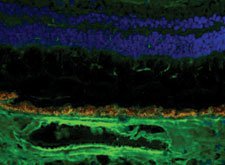Investigators identify AMD gene
BETHESDA, Md. – Here at the National Institutes of Health’s Clinical Center in June, four National Eye Institute grantees, who all published their results between March and May, unveiled a new “strongly associated” gene for developing early AMD (e-AMD). Opening this NEI-sponsored symposium, long-time AMD researcher, NEI Director Paul A. Sieving, MD, PhD, said, “This significant step in AMD research confirms a strong genetic component of AMD, which may allow scientists to develop tests for the disease before symptoms begin to appear and when therapies might help slow its progression.”
Understanding CFH’s role
|
|
Michael K. Pangburn, PhD, an expert on complement factor H (CFH), explained at the symposium: “Factor H is a component of one of the three complement system pathways. Hot spots for mutations associated with disease are found in domains 7 and 20 of factor H. The mutations in domain 20 are important in atypical hemolytic uremic syndrome while those in domain 7 appear to be more critical for AMD.”
NEI grantee, Gregory Hageman, PhD, stated that “there were ample previous data to suggest that activation of the complement cascade plays a critical role in drusen formation and the etiology of AMD.” Studies of patients with glomerulonephritis who also have macular drusen suggested that Factor H was a strong AMD candidate gene. This team then showed a highly significant association of 8 CFH single-nucleotide polymorphisms (SNPs) with AMD.
Looking at drusen as a biomarker of AMD, they found that complement pathway proteins are present in drusen and synthesized by the retinal pigment epithelium. They also found that the complement activation pathway can kill ocular cells and tissues.
Dr. Hageman’s studies of both AMD and e-AMD found the complement pathway active in all stages of AMD.
Because inflammation in the form of complement activation is “robust,” “We are beginning to envision the therapeutic applications that might exist,” Dr. Hageman said. He believes the “events that trigger and activate targets for the development of complement system are key targets for AMD.”
Defining complement factor H
In 1995, Albert O. Edwards, MD, PhD, and colleagues found a gene on chromosome 1q31 in a family with more than three generations of primarily dry AMD.
A polymorphism that changes tyrosine to histidine at amino acid position 402 was identified in the gene encoding CFH. “Persons with a least one copy of CFH with histidine at this site may account for 50% of the attributable risk of AMD,” he emphasized.
Dr. Edwards added, “Of the 30.5 million white people older than 65 in the United States, 4 million people have large drusen (> 125 µm). However, 10 million in this age group without large drusen would test positive for the histidine variant. Thus, genetic testing is not indicated for patient care.”
Link between 1q32 and CFH
Jonathan L. Haines, PhD, reported at the symposium that his team identified a strong association between the AMD locus on chromosome 1q32 and CFH. After CFH gene resequencing, a common coding variant revealed that the risk for AMD increases between 2.45 and 5.57 times. This variant “likely explains approximately 43% of AMD acquisition in older adults,” he said.
The characterization of clinical severity followed the Age-Related Eye Disease Study from no drusen to neovascularization. “After identifying chromosome 1q32, we looked at the linkage results and tested for the association in two independent datasets,” Dr. Haines said.
CFH link with 1q31, 1q32
To understand AMD biology, NEI researcher, Josephine Hoh, PhD, traced familial association in studies performed between 1973 and 2005. “We have found multiple risk factors and very large drusen of >125 µm, which identified both 1q31 and 1q32 loci for the CFH ‘risk variant’,” she said.
This team also found the amino acid tyrosine changed to histidine in the protein regions of Factor H. The linkage disequilibrium occurred at the amino acid 402 site, and the CFH region binds with C-reactive protein. After genotyping 116,204 SNPs, a common variant in the CFH genes likely increases the risk factor of AMD by 7.4 times.
The researchers tested the AMD association at each of the SNPs. “This histidine variant almost always occurs as a risk association with AMD,” Dr. Hoh reported.
For Your Information:
- Michael K. Pangburn, PhD, can be reached at the Biomedical Research Dept., University of Texas HSC at Tyler; (903) 877-7663; e-mail: michael.pangburn@uthct.edu.
- Gregory Hageman, PhD, can be reached at the Department of Ophthalmology and Visual Sciences, University of Iowa; (319) 384-9722; e-mail: gregory-hageman@uiowa.edu.
- Albert O. Edwards, MD, PhD, can be reached at the Institute for Retina Research, Presbyterian Hospital of Dallas; (214) 345-6801; e-mail: albert.edwards@dallasretina.com.
- Jonathan L. Haines, PhD, is the T.H. Morgan Professor of Human Genetics, professor of molecular physiology and biophysics and director of the Center for Human Genetics Research, Vanderbilt University Medical Center, Nashville; (615) 343-5851; e-mail: jonathan@chgr.mc.vanderbilt.edu.
- Josephine Hoh, PhD, can be reached at Yale School of Medicine, Epidemiology and Public Health, (203) 785-2888; e-mail: josephine.hoh@yale.edu.

